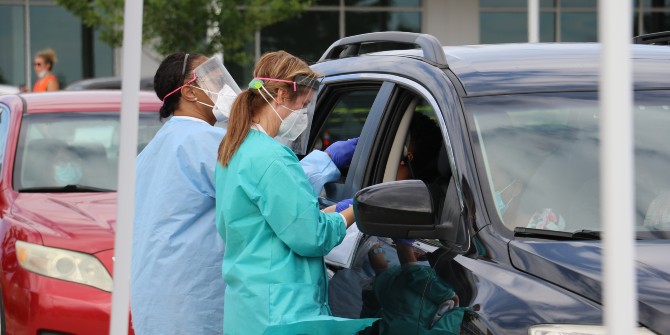Mass testing programmes like the Liverpool pilot rely on people’s willingness to come forward for testing, knowing that it may lead to self-isolation and loss of income. Tim Besley (LSE), Andrea Galeotti (London Business School), Jakub Steiner (University of Zurich and CERGE-EI) and Paolo Surico (London Business School) set out an alternative model for Test and Trace, where organisations like universities and businesses would take responsibility for testing, and those testing positive and their contacts get sick pay.
The challenge
With COVID-19, many infectious individuals are asymptomatic. This makes mass testing essential for the success of any track-and-trace programme. The UK government has announced its intention to employ a battery of different tests (“existing swab tests, lateral flow tests, LAMP technology”) to achieve mass testing. And a pilot is now underway in Liverpool, an enterprise that was described in a recent government press briefing:
Mass testing will be “provided through a partnership between Liverpool City Council, NHS Test and Trace and Ministry of Defence, with logistical support from Armed Forces personnel”. Testing is offered to everyone and it is voluntary. “Testing will be carried out in new and existing test sites, using home kits, in hospitals and care home settings, and schools, universities and workplaces”
This pilot is important and it is refreshing to see a collaboration between the national government and the local administration. But there are a number of considerations which we believe should be taken into consideration when designing mass testing programme for COVID-19. We conclude with recommendations to improve upon the existing design of the Liverpool pilot and for future programmes that try to achieve this goal.

Some observations on programme design
1. The usefulness of mass testing for track and trace depends on the behavioural response of individuals. There are two plausible responses that could undermine mass testing effectiveness. First, individuals may be reluctant to take the test knowing that it may imply self-isolation for them and their household. Second, individuals may be tempted to conceal the result of the test knowing that, otherwise, they and their household may need to self-isolate sometimes at a high personal cost. Likewise, individuals may not comply with any quarantine requirements. Hence compliance cannot be taken for granted.
Even if there is a high participation rate in a place like Liverpool, this is not necessarily informative for future participation in such programmes. In particular, given the existing national lockdown, the individual cost to take a test and self-isolating after a positive COVID test is lower than it will be after the lockdown is lifted. In general, a mass testing programme must design appropriate incentives for individual participation, as well as for individual compliance following a positive test. At present, such incentives are weak for a range of occupations where working from home is not realistic.
2. Mass testing deployment in Liverpool is conducted by the local authority, together with the national government. People can undertake a test in new and existing test sites. As far as we understand, there is little coordination with local organisations and workplaces. There are two main drawbacks with this approach:
First, organisations may internalise the positive external benefits that testing has for the effectiveness of track and trace more than individuals do. This means that organisations may be a better vehicle for providing incentives to their members to participate in these programmes. It is notable that a number of universities, as well as some forms of business such as professional football, have been most effective in implementing track and trace programmes. And this is not entirely because of wider societal benefits, but because they are integrated into the successful operation of these businesses.
Second, most of the information about correlation in health status amongst individuals cannot be used unless testing is delegated to organisations. In the current situation, where prevalence is high, this may not be a first order concern because the incidence of false positives will be low relative to the total number of positive tests. However, once the virus has been suppressed and prevalence becomes very low (which is the situation in which contact tracing is most important), even a 1% false positive rate means that the vast majority of positive documented cases are likely to be false positives. Individuals will soon realise that testing positive has little meaning, and this may create even more of a disincentive to take part in those prevention programmes. In contrast, if testing is done within organisations, when prevalence is very low, the organisation can combine the test outcome of different individuals to improve the prediction as to whether a positive test reflects a true infection, or a false positive. We know SAGE and others are aware of these technicalities. We only want to point out that, given the information we have, the current Liverpool design throws away the possibility of exploiting information about correlation of health status across individuals.
On the basis of these considerations, we encourage an evaluation of a stronger collaboration between local authority/national government and local organisations like universities, colleges, schools and workplaces where trust is high and incentives are strong.
Specifically, we propose:
1. Mass testing should be delegated to organisations. National government and local authorities would allocate testing capacity to them and offer logistic support. Organisations are guided in how to use their specific information about individuals’ interaction and correlation across health status within the organisation.
2. Organisations are responsible for communicating the outcome of testing to NHS track and trace.
3. Organisations are responsible for communicating the outcome of testing to individuals and, after a positive result, an individual will be asked to self-isolate for a specific number of days.
4. Self-isolation can be treated as paid sick leave, so that the worker is not penalised financially.
5. National government and local authorities subsidise organisations for sick leave pay due to COVID-19.
6. Organisations have an incentive to take part in these programmes by being allowed to remain open, and because they can recoup losses due to workers self-isolating.
This approach better integrates economic and scientific thinking. Tying support programs to test and trace participation is essential. It improves incentives and by protecting individuals better if they are asked to isolate, it will increase compliance as well as public support for the programme. Although there may be still be some gaps in the coverage (for example, it does not fully address the situation faced by many self-employed workers), it is more promising than putting local authorities at the heart of the system.
The government has also recently announced that individuals who came into contact with positive COVID-19 cases will not be asked to self-isolate, but will instead be tested every day for a week. They will only need to self-isolate if their test is positive. This may encourage test participation, since it reduces the cost of isolation imposed on the peers of the people testing positive. This beneficial shift in incentives needs, however, to be weighed against the possibility that the test result was a false positive and the contacts were never exposed to the virus.
As we come out of the current lockdown, a new system of track and trace must be built that takes the reality of incentives among workers and organisations seriously in every part of the process.
This post represents the views of the authors and not those of the COVID-19 blog, nor LSE.





